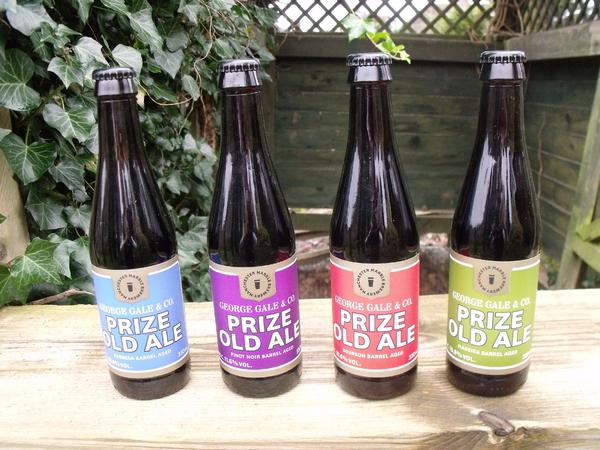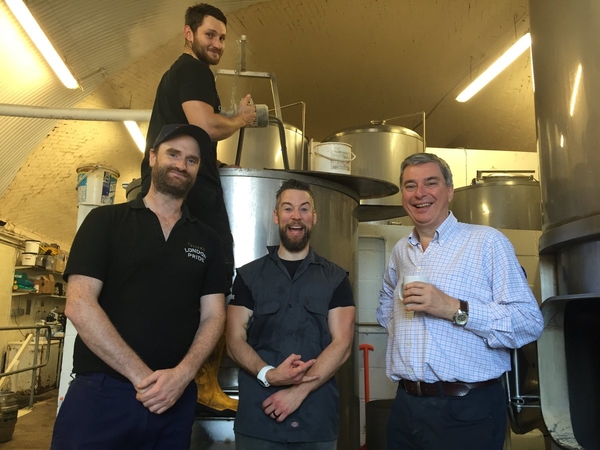Fuller's & Marble revive classic old ale
Added: Wednesday, December 27th 2017

The revival of Gale’s Prize Old Ale will delight lovers of an English beer style that seemed destined to become just a footnote to the history of brewing. The restoration is the result of a remarkable collaboration between a big brewer, Fuller’s of London, and Marble, a Manchester-based micro.
Old Ale was once a dominant English style, aged in wood for months and even years. Ageing developed a lactic, acidic tang from wild yeasts trapped in the wood, a characteristic that found favour with drinkers in the 18th and 19th centuries, who called the beer “stale”.
It could be drunk on its own but was also used for blending: for example, it was one of the base beers of the early Porters and Stouts of the 18th century. It was also known as Stock Ale and was mixed with “running beers” that had not been aged and needed a boost from the rich and complex flavours of the older ale.
Old Ale has declined in recent times but devotees of the style can take comfort from the fact that the Gale’s interpretation has not only been restored but will become an annual vintage.
George Gale & Co was a family-owned brewery founded in 1847, with close links to Portsmouth, where it supplied the navy with beer. In the 1920s, a new head brewer arrived from Yorkshire and brought with him a recipe for a strong beer. It was almost certainly based on a style known as Yorkshire Stingo, still brewed today by Samuel Smith of Tadcaster, where it’s aged in wood for a year.
Prize Old Ale stayed in production for 80 years until the brewery was bought and closed by Fuller’s in 2006. For most of that time, the beer was aged in wooden hogsheads for between six months and a year, and as a result picked up a pronounced lactic tang from wild yeasts, Brettanomyces in particular. Brettanomyces – “Brett” for short -- is the scientific name for “British fungus” and its funky, “horse blanket” character came to prominence with the popularity of Porters and Stouts as well as Old Ale.
John Keeling, Fuller’s head brewer at the time of the takeover, said he “fell in love” with Prize Old Ale and was determined to keep it in production.
“The challenge was how to replicate it at Fuller’s. We didn’t have room at Chiswick for Gale’s wooden fermenters. So we brewed a final batch at Gale’s and transferred it to Chiswick and stored it in a metal tank.
“We brewed it twice in 2007 and 2008, with half the beer from the tank blended with a fresh batch and still using the Gale’s yeast, which we’d propagated at Fuller’s,” John says.
“The problem was, the sales team hated it and said they couldn’t sell it. They called it a dying beer. But I wasn’t prepared to chuck away the remaining beer. I thought it could be popular again.”
Help came from Marble Brewery in Manchester. John Keeling is a Mancunian and he was delighted to link up with James Kemp at Marble who, John knew, shared his passion for Old Ale.

James is a New Zealander. He was a keen home brewer in the Wellington area and won awards from the Yeastie Boys brewery there before moving to Britain. He worked for a while at Fuller’s and Thornbridge before joining Marble.
James says, “I find Old Ales to be as fascinating and complex as Flanders Reds and Oud Bruin from Belgium. Their mixed culture fermentation gives them an initial complexity but with age comes even deeper layers of complexity.
“Every time I drink these beers I think about the possibilities that would exist if British breweries continued to brew in this manner. I’d been dreaming of doing just that for many years until a series of direct messages on Twitter from John Keeling got the ball rolling.”
They met for a discussion over a pint about their love of the style and then John went back to Fuller’s sent James batch of Prize Old Ale.
“We decided to brew at the start of 2016,” James says. “We started things off by exchanging recipes. I scaled the original recipe from 1926 down to Marble size and found there’s a charming link between Gale’s and Marble, as our house yeast is said to be Gale’s in origin – so we were off to a good start.”
John Keeling thinks the yeast culture originally came from the national brewer Whitbread and it “metamorphosed into Gale’s”. (Image above: James Kemp centre and John Keeling right with members of the Fuller's and Marble team.)
The beer brewed at Marble was made up of pale, crystal and chocolate malts and glucose syrup. Bittering hops were 50:50 Challenger and Goldings with Fuggles and Goldings for aroma, split 80/20 in favour of Fuggles. Units of bitterness are 53.
James says, “The brewing day went well and fermentation progressed as planned. Famously, Gale’s fermented their Old Ale in oak vats and then transferred it to hogsheads before bottling.
“As we don’t have foudres [oak vats] or similar vessels, I decided to ferment the first beer clean in a fermenting vessel, inoculate with Gale’s mixed culture yeast and then fill into barrels.”
He had four types of barrel available: second-fill Bourbon; first-fill Madeira; first-fill Barbera; and second-fill Pinot Noir.
“Once I’d inoculated our beer, I purged each barrel with CO2 and filled them,” James records. “Over the next year, I kept an eye on the beer, moving it to warmer or cooler areas of the brewery depending on how the Brettanomyces character was developing and to minimise acetic acid production.
“The big decision I had to make was how to blend. I had thought to create an overall blend and package it as a single beer, but I decided the character from the different types of barrels was significant enough to warrant packaging separately.
“Once I was happy with the maturity of the beer, we packaged into bottle and keg to condition.”
Tasting notes
Bourbon barrel-aged (10.6%)
Flaring ruby-red colour. A big acidic “horse blanket” nose with oak and vanilla notes, toasted grain and peppery hops. Warming whiskey notes on the palate, with oak, vanilla, tart fruit, rich malt and spicy hops. Oak and vanilla build in the finish, with growing peppery hops notes, tangy fruit and finally ending dry and acidic.
Barbera barrel-aged (10.4%)
Darker and slightly hazy ruby-red hue and a less acidic nose with rich vinous fruit, creamy vanilla, oak, smoke and gentle, spicy hops. Acidic notes build in the mouth with pronounced oak, vinous fruit, juicy malt and spicy hops. Warming alcohol, tart fruit, oak, vanilla, juicy malt and spicy hops combine in the long and complex finish.
Madeira barrel-aged (10.9%)
Vast fluffy head with a chestnut-coloured beer. Big funky notes on nose overwhelms malt but good peppery hop and vanilla notes. A rich palate of creamy malt, vinous fruit, sugared almonds, vanilla, oak and peppery hops. Sweet malt and vinous fruit build in the finish, with declining hop notes and a solid underpinning of vanilla and oak.
Pinot Noir barrel-aged (11.6%)
Glowing ruby-red colour. Funky notes on nose balanced by ripe vinous fruit, spicy hops and creamy malt. Vanilla and creamy malt dominate the palate with tart fruit, funky notes and spicy hops. Sweet fruit and malt build in the finish with increasingly bitter and spicy hops, fading acidity and continuing oak and vanilla notes.
https://shop.hopburnsblack.co.uk/products/marblexfullersgaleprizeoldalepinotnoirba116330ml
*One beer brewed in a manner not dissimilar to Gale’s is Greene King’s Strong Suffolk Ale. The brewery dates from 1799 and still has a number of large oak vats where it ages a strong dark ale called Old 5X, 12% alcohol, for around a year. It emerges with a lactic tang and is blended with a second beer, BPA, 5%, with a final strength of 6%.
In spite of lobbying by beer writers, Greene King filters and pasteurises the beer: it would take on far more interesting character if it were allowed to age in bottle with live yeast.
James Kemp’s comment about Flanders Red and Oud Bruin from Belgium stresses a link between beers produced in eastern England and those in the Low Countries. The best-known “sour red” beer in Belgium comes from the Rodenbach brewery in Roeselare, which dates from 1820. A member of the family, Eugene, visited England in the 1870s to study brewing methods and returned to develop a beer called Grand Cru that’s aged for 18 months in tall wooden vats.
There has been speculation that Eugene may have included Greene King on his tour: that is unlikely, as the Suffolk brewery didn’t open until 1799. However, there would have been no shortage of breweries that aged beer in wood in England at the time.









